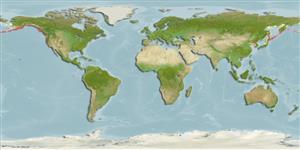Actinoptérygiens (poissons à nageoires rayonnées) >
Scorpaeniformes (Scorpionfishes and flatheads) >
Cottidae (Sculpins)
Etymology: Clinocottus: Greek, klinein, kline = sloping and bed, due to the four apophyses of sphenoid bone + Greek, kottos = a kind of fish (Ref. 45335).
Environnement / Climat / Gamme
Écologie
; marin; eau douce; saumâtre démersal; profondeur 0 - 20 m (Ref. 96339). Temperate, preferred ?; 66°N - 34°N
Eastern Pacific: Bering Sea coast of Alaska to Big Sur River, central California, USA.
Taille / Poids / Âge
Maturity: Lm ? range ? - ? cm
Max length : 6.4 cm TL mâle / non sexé; (Ref. 2850); common length : 4.4 cm TL mâle / non sexé; (Ref. 12193)
Description synthétique
Morphologie | Morphométrie
Épines dorsales (Total): 7 - 9; Rayons mous dorsaux (Total): 14-16; Épines anales 0; Rayons mous anaux: 10 - 13; Vertèbres: 32 - 33. Distinguished by the flattened tripartite anal papilla and the cirri on the eyeballs, head, lateral line and at the tip of each dorsal spine (Ref. 27547). Gill rakers reduced to low smooth mounds; lateral line high toward the head, curving downward to middle of sides, straight toward the tail, each of the anterior 15 or so pores having a slender cirrus (Ref. 27547). Next to the last anal ray longer than the rays before and behind it; pectorals reach to or just beyond front of anal fin; caudal rounded (Ref. 6885, 27547). Color varies with the environment, sometimes nearly uniform bright green but more often green to light brown above with dark wedge-shaped saddles, broader below, on upper part of sides, with lighter color between; sometimes, along or below lateral line, a dark longitudinal stripe that is in some cases interrupted with light spots; ventral region creamy to white; three dark lines radiating from the eye, the first to the snout, another downward to behind the mouth, the third rearward to base of preopercular spine; spiny dorsal with a dark blotch between first and third spine; pelvic fins plain, others usually dusky, mottled or indistinctly barred (Ref. 27547).
Commonly found in rocky intertidal and subtidal areas, but also over sand and in eelgrass and seaweeds (Ref. 2850). May leave tide pools if aquatic conditions become inhospitable (Ref. 31184). Occasionally enters fresh water (Ref. 27547). Probably feeds on small invertebrates common among seaweed and in tide pools. Breathes air when out of water (Ref. 31184).
Life cycle and mating behavior
Maturité | Reproduction | Frai | Œufs | Fécondité | Larves
Eschmeyer, W.N., E.S. Herald and H. Hammann, 1983. A field guide to Pacific coast fishes of North America. Boston (MA, USA): Houghton Mifflin Company. xii+336 p. (Ref. 2850)
Statut dans la liste rouge de l'IUCN (Ref. 115185)
CITES (Ref. 94142)
Not Evaluated
Menace pour l'homme
Harmless
Utilisations par l'homme
Pêcheries: sans intérêt
Plus d'informations
Taille/ÂgeCroissanceLongueur-poidsLongueur-longueurFréquences de longueursMorphométrieMorphologieLarvesDynamique des populations larvairesRecrutementAbondance
RéférencesAquacultureProfil d'aquacultureSouchesGénétiqueFréquences alléliquesHéritabilitéPathologiesTraitementMass conversion
CollaborateursImagesStamps, CoinsSonsCiguateraVitesseType de nageSurface branchialeOtolithesCerveauxVision
Outils
Articles particuliers
Télécharger en XML
Sources Internet
